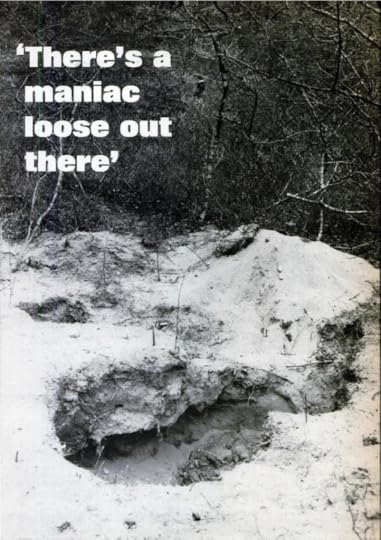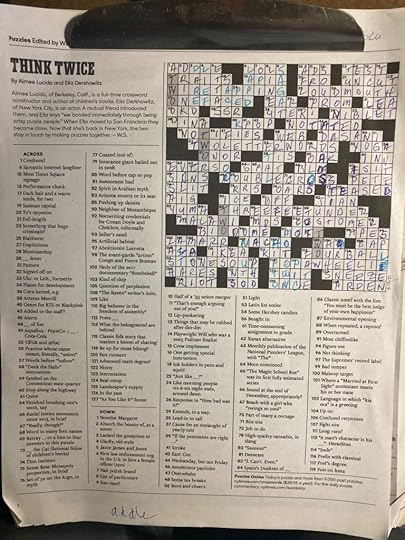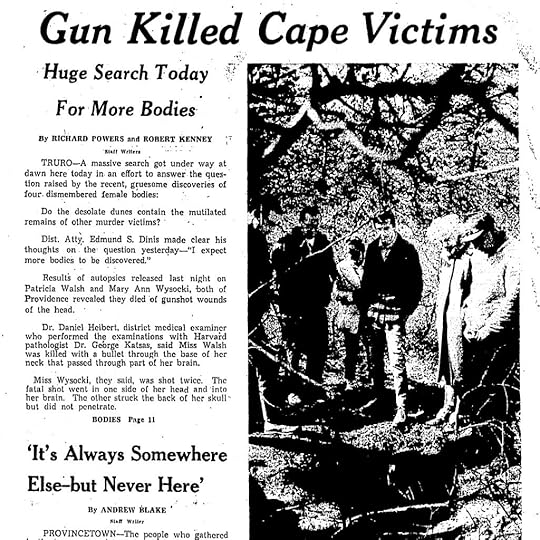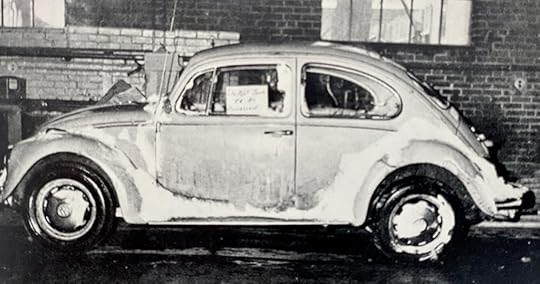Liza Rodman's Blog, page 2
November 30, 2021
Holiday Gift – The Babysitter: My Summers with a Serial Killer
“For your true-crime devouring best friend who’s listened to every My Favorite Murder episode.”
— NEWSWEEK ON THE BABYSITTER, PERSONALIZED BOOK PICKS FOR EVERYONE ON YOUR GIFT LIST.
 The Babysitter: My Summers with a Serial Killer is a great gift for true crime fans, memoir enthusiasts, or any book lover on your gift list.Where to Purchase: Gift a hard cover copy.
The Babysitter: My Summers with a Serial Killer is a great gift for true crime fans, memoir enthusiasts, or any book lover on your gift list.Where to Purchase: Gift a hard cover copy. Message Liza Rodman if you’ve like a signed bookplate.Gift an audio book—perfect for those last minute gifts. Pre-order a paperback copy. Paperback versions of The Babysitter will hit stores in June 2022 but you can pre-order a copy today from Simon & Schuster, Amazon, or Barns & Noble. We will make an annoucment as soon as it’s available for pre-order on indiebound.org and bookshop.org. About The Babysitter
A chilling true story—part memoir, part crime investigation—about a little girl longing for love who found friendship with her charismatic babysitter—who was also a vicious serial killer.
Liza Rodman was a lonely little girl. During the summers, while her mother worked days in a local motel and danced most nights in the Provincetown bars, her babysitter—the kind, handsome handyman at the motel where her mother worked—took her and her sister on adventures in his truck, sometimes to his “secret garden” in the Truro woods. He was one of the few kind, understanding adults in her life.
But there was one thing she didn’t know; their babysitter was a serial killer.
Some of his victims were buried—in pieces—right there, in his garden in the woods. Though Tony Costa’s gruesome case made screaming headlines in 1969 and beyond, Liza never made the connection between her friendly babysitter and the infamous killer until decades later. Read more.
“…engrossing memoir…this tragic tale of a dysfunctional family and a psychopath is a page turner.”
— BOOKREPORTER ON THE BABYSITTER
The post Holiday Gift – The Babysitter: My Summers with a Serial Killer appeared first on Liza Rodman.
November 22, 2021
Incised Wounds
I never signed up to be a forensic journalist, but here I am. It happened about two months and ten boxes into my research on The Babysitter. Those ten boxes, and a few more since, had been collected by Liza in the years since her fateful nightmare in which she finally saw the face of her nocturnal stalker—Tony Costa, her babysitter turned serial killer. When it came my turn to delve into her exhaustive trove of documents, as well as online articles about Costa and his bloody brethren of serial killers, one “fact” about his case was particularly horrific: his victims showed signs of having been bitten. That “fact” was revealed when the District Attorney at the time held a press conference and announced that Costa’s victim’s body parts found in the Truro woods had shown teeth marks, and that some had even been chewed. And just like that, Costa was dubbed the Cape Cod Cannibal, a modern day vampire, in newspapers across the country.
In order to fully understand what I was now confronting, I called a friend and doctor to read through the victims’ autopsy reports with me. A kind and gentle man dedicated to healing, Dr. Kent DiFiore specializes in oncology not forensic medicine but I knew he’d be able to walk me through the technical jargon. As we sat in his sunny kitchen, my tape recorder capturing his explanations of the carnage done to Costa’s victims, I kept waiting for “teeth marks,” or “bites,” or “chewed” to appear in order to explain the DA’s statement. Suddenly Kent read, “incised wounds.” Ah ha!
“Can you explain what an incised wound is?” I asked, fully expecting him to confirm the grisly details.
“That’s a wound caused by a sharp object. Think incision.”
“So, not bitten or chewed?”
Kent looked at me over the rim of his reading glasses, a look of painful shock on his face; these were clearly not your run-of-the-mill autopsy reports.
“What? Chewed? No! These women were brutalized, but they weren’t chewed.”
And I suddenly realized what had happened at that press conference back in 1969. The DA had read the same autopsy report, seen the same “incised wound,” and instead of incision had thought “incisor,” as in tooth. And so the catchy but entirely erroneous moniker of Cape Cod Cannibal was born. In fact, given how sloppy and often lazy most chroniclers of Costa’s crimes have been, if you Google his name, in many online sources you still will read that he “ate his victims’ body parts.” But you won’t read it in this online source because we did our research.
As unspeakable as Costa’s crimes were, they didn’t include feasting on his victims. The women Costa murdered and buried in the Truro woods deserve a better epitaph than having been victims of a so-called vampire and we hope The Babysitter will help rewrite that legacy.
 “Hidden in the tangled ‘upland’ behind Truro cemetery is a shallow hole in the Cape Cod sand. It is one of three graves, found earlier this year, that held the hacked-up remains of four girls at left.” Vonnegut, Kurt, Jr. LIFE. Vol. 67 No. 4. July 25, 1969. 53.
“Hidden in the tangled ‘upland’ behind Truro cemetery is a shallow hole in the Cape Cod sand. It is one of three graves, found earlier this year, that held the hacked-up remains of four girls at left.” Vonnegut, Kurt, Jr. LIFE. Vol. 67 No. 4. July 25, 1969. 53.The post Incised Wounds appeared first on Liza Rodman.
September 7, 2021
Grampy
When my grandfather died, I said to myself, I will never know anyone funnier than Grampy. And I was right. It’s been forty years since his death and I have yet to meet a soul with the speed and cleverness of his wit. It definitely wasn’t a kind and gentle humor, but it wasn’t nasty either. It was just so damn quick and sure, like the thrust of an epee’s blade, especially after his nightly scotch and sodas — plural.
Another of his traits, and one I did inherit, was his love of crossword puzzles. He and my grandmother split their life between Cape Cod and Southern Florida, and we would visit both places, fleeing a cold and dreary Vermont to follow them to the sun and warmth. Every day we were there, weather willing, we would haul our chairs and towels to the beach where Grampy would hold court — his tan legs crossed at the knees like a debutant’s and a perpetual cigarette between his fingers – while we would sit at his feet listening to his stories, watching him greet admirers who’d stop at his chair to say hello, and, best of all, helping him with the New York Times Sunday crossword puzzle.

He attached the puzzle to an old wooden clipboard, propped it on his lap, and worked through the clues, his pencil scratching in answers as he went. And we’d wait. When he came to a clue that was either easy enough for us or one that truly stumped him, he’d call out – “Emulates a chipmunk, eight letters, first letter s.” “Simple life? with a question mark, five letters, second letter m.” “Advantage, five letters, fourth letter u.”
We’d call out our guesses, but we’d usually not have counted correctly.
“No, no. I said five letters. That’s seven.” Oh, right.
And whenever I’d get an answer, if felt like Christmas morning as he bestowed the gift of admiration.
“Wow! That’s it!” Grampy would exclaim, filling in the letters. “Good job, Jenny. Here’s another one you should get.”
It would take Grampy nearly the full week to complete the puzzle and if he hadn’t finished it by the time the Times arrived on Sunday morning, he never allowed himself to start the new one until he did. It was perhaps his only discipline, but it was sacred.
Now, forty years later, I too have the puzzle addiction but because I am not a retired eighty-year-old and can’t spend my days in a beach chair, I have to get it done on Sunday. And I do. It’s not that I am smarter than my grandfather was, but I am more tenacious. And, I am less distracted by admirers stopping at my beach chair and grandchildren asking for a quarter to buy a hot dog at the food shack in the dunes.
Besides, finishing the puzzle on Sunday is my discipline and it too is sacred.
The post Grampy appeared first on Liza Rodman.
August 18, 2021
But Is It True?
“And they were never seen alive again.” It was the sentence that stopped my fingers on the keyboard.
You see, for decades, fifty years in fact, the fate of three young women was a mystery. All that was known about their “disappearance” was that the last recorded sighting of them was with Tony Costa, a man who would later be convicted for the murders of two women and guilty in the deaths of three more, as well as the disappearances and presumed murders of as many as another eight. So, when investigators went looking for these three women to determine if Costa had had a hand in their demise, the women were nowhere to be found. Or so it was thought. And in 1969, who knows how hard the police and prosecution looked.
Imagine; a blue-suited cop with a badge and a gun, perhaps accompanied by an investigator wearing the standard-issue trench coat and fedora, come knocking at the door of a Haight Ashbury commune. It doesn’t take much of a stretch to envision a troupe of long-haired hippies, clad in torn jeans and leather vests, jumping out of windows and fleeing back doors amid a cloud of marijuana smoke as the police stood at the front door.
“Any of you creeps seen this girl?”
The cop pushes a faded photograph into the bloodshot eyes of the unfortunate too stoned to flee with the others.
“Nope, never seen her,” says the kid, wiping the hair from his forehead, then perhaps muttering, “Pig,” under his breath as he slams the door.
Or picture if you will, another set of investigators not even sure where to look for two teenage girls who ran away from high school, and home – perhaps somewhere in Pennsylvania, perhaps somewhere near Sarasota, Florida, depending on which story Costa was telling them at the time. In their “search” for these girls, they didn’t even attempt a road trip; they merely made a few calls and, unable to locate either girl, declared them missing – two more presumed dead at the horrific hands of Costa.
Now jump ahead fifty years when Liza and I are digging back into the story and Costa’s victims, trying to learn their fate. As we read through a blizzard of papers on the case – trial transcripts, police records, investigators’ reports, press coverage, Costa’s own prison diary, an unpublished book heavily sourced by Costa, and a variety of websites focused on serial killers – we gleaned nothing new; every chronicler since 1969 had simply cut and paste the sentence, “and they were never seen alive again.”
But when it came time for me to write the same sentence, something tugged at my journalistic roots and stopped my fingers on the keyboard. That something was — I didn’t know the sentence to be true. In fact, I could almost envision one of the women, perhaps all three, reading “The Babysitter” only to see her name and learn of her untimely death and exclaim, “Not so fast, Jennifer!”
So I did what was unavailable to those investigators in 1969 – I Googled, I cross-referenced with Facebook and Ancestry.com, I employed online search engines, phone books, and high school yearbooks — until I came up with a short list of women with the same or similar names and then started calling and sending letters and emails.
And sure enough, I found them. All three. Well, I found their sisters and daughters – each of the three had since died, but none at the hands of Tony Costa.
A sister of one of the women, when I told her how history had recorded her sister’s murder by the Cape Cod Cannibal, told me, “I can picture [her] sitting there with a scotch, a cigarette in her hand, slapping her leg and laughing hysterically saying, ‘you mean that wuss from Provincetown was a serial killer? No way. I could have taken him down with one arm behind my back!’”
Oh, that she had had the chance.
The post But Is It True? appeared first on Liza Rodman.
May 11, 2021
Dani Shapiro’s Family Secrets Podcast
On a Sunday morning, 2013 I opened the newspaper and read a review of Dani Shapiro’s nothing short of brilliant book, Still Writing. A frustrated and inexperienced writer most of my life, I quickly ordered it and took it along on an April writing retreat. As the sun rose and set on a couple of glorious days of quiet, I finished the book. In fact, I could not put it down. Every page spoke to me, to my loves, my frustrations, my wounds. When I got home, I quickly ordered everything else she had ever written and googled her to learn about the person who had written this beautiful book. We all have a literary hero or two. In the Spring of 2014, Dani Shapiro joined Lillian Hellman as mine.
In 2019 Dani Shaprio’s memoir Inheritance became an instant NYTimes bestseller. In the wake of that success, she partnered with iHeart Media and together they launched the Family Secrets Podcast. This past week, Family Secrets received a Webby nomination. Now, on May 20th, another new, season five episode of Dani Shapiro’s Family Secrets Podcast will drop with me as her guest. Can you stand it? We will be discussing my new book about my childhood summers in Provincetown, Massachusetts, co-written with my dear friend and award-winning journalist, Jennifer Jordan, The Babysitter: My Summers with a Serial Killer. And if that’s not a full circle moment, I don’t know what is!
Remember this: Dreams do come true. And don’t forget to download and listen to all five seasons of Family Secrets.

The post Dani Shapiro’s Family Secrets Podcast appeared first on Liza Rodman.
March 1, 2021
But Is It True?
“And they were never seen alive again.” It was the sentence that stopped my fingers on the keyboard.
You see, for decades, fifty years in fact, the fate of three young women was a mystery. All that was known about their “disappearance” was that the last recorded sighting of them was with Tony Costa, a man who would later be convicted for the murders of two women and guilty in the deaths of three more, as well as the disappearances and presumed murders of as many as another eight. So, when investigators went looking for these three women to determine if Costa had had a hand in their demise, the women were nowhere to be found. Or so it was thought. And in 1969, who knows how hard the police and prosecution looked.
Imagine; a blue-suited cop with a badge and a gun, perhaps accompanied by an investigator wearing the standard-issue trench coat and fedora, come knocking at the door of a Haight Ashbury commune. It doesn’t take much of a stretch to envision a troupe of long-haired hippies, clad in torn jeans and leather vests, jumping out of windows and fleeing back doors amid a cloud of marijuana smoke as the police stood at the front door.
“Any of you creeps seen this girl?”
The cop pushes a faded photograph into the bloodshot eyes of the unfortunate too stoned to flee with the others.
“Nope, never seen her,” says the kid, wiping the hair from his forehead, then perhaps muttering, “Pig,” under his breath as he slams the door.
Or picture if you will, another set of investigators not even sure where to look for two teenage girls who ran away from high school, and home – perhaps somewhere in Pennsylvania, perhaps somewhere near Sarasota, Florida, depending on which story Costa was telling them at the time. In their “search” for these girls, they didn’t even attempt a road trip; they merely made a few calls and, unable to locate either girl, declared them missing – two more presumed dead at the horrific hands of Costa.
Now jump ahead fifty years when Liza and I are digging back into the story and Costa’s victims, trying to learn their fate. As we read through a blizzard of papers on the case – trial transcripts, police records, investigators’ reports, press coverage, Costa’s own prison diary, an unpublished book heavily sourced by Costa, and a variety of websites focused on serial killers – we gleaned nothing new; every chronicler since 1969 had simply cut and paste the sentence, “and they were never seen alive again.”
But when it came time for me to write the same sentence, something tugged at my journalistic roots and stopped my fingers on the keyboard. That something was — I didn’t know the sentence to be true. In fact, I could almost envision one of the women, perhaps all three, reading “The Babysitter” only to see her name and learn of her untimely death and exclaim, “Not so fast, Jennifer!”
So I did what was unavailable to those investigators in 1969 – I Googled, I cross-referenced with Facebook and Ancestry.com, I employed online search engines, phone books, and high school yearbooks — until I came up with a short list of women with the same or similar names and then started calling and sending letters and emails.
And sure enough, I found them. All three. Well, I found their sisters and daughters – each of the three had since died, but none at the hands of Tony Costa.
A sister of one of the women, when I told her how history had recorded her sister’s murder by the Cape Cod Cannibal, told me, “I can picture [her] sitting there with a scotch, a cigarette in her hand, slapping her leg and laughing hysterically saying, ‘you mean that wuss from Provincetown was a serial killer? No way. I could have taken him down with one arm behind my back!’”
Oh, that she had had the chance.
The post But Is It True? appeared first on Liza Rodman.
February 15, 2021
February 15, 1969
“Tony had a way of making a story so convincing you could almost see it in front of you.”
Steve Grund
During the week of February 15, 1969, while the Barnstable County Medical Examiner tried in vain to identify the remains of the young woman found in the Truro woods on February 8th, teams of police and cadaver dogs continued to search the Truro woods. In the winter quiet, an occasional State Police helicopter could be heard overhead. And the year round residents in a usually slumbering Provincetown were wide awake, and gossiping.
When Tony was in town he often dropped in at the Provincetown police station unannounced and demanded to see detectives assigned to the case telling one incredible, ever changing story after another. In one such incident, he left the precinct in a huff after shaking his finger in the face of State Police Detective George Killen. “You’ll hear from my attorney,” he said as he stormed out into the raw February air. Finally, tired of his bizarre antics, obvious lies, strange affect and differing stories, Detective George Killen told Tony he was in serious trouble and to get a lawyer.
 Boston Globe, March 7, 2969
Boston Globe, March 7, 2969 Truro Woods
Truro WoodsThe post February 15, 1969 appeared first on Liza Rodman.
February 8, 2021
February 8, 1969
In The Babysitter: My Summers With a Serial Killer, it seems every day of the year represents some gruesome milestone, but perhaps none so dark as today. On February 8th in 1969, the dismembered, defiled body of a young woman was found in a shallow grave alongside Old Proprietors Road in the Truro woods on Cape Cod. The police had been searching the woods for two missing women from Providence, RI, but they stumbled on something far more sinister. It would take a full two months for police to identify her ruined remains.
For songs that will transport you back to Provincetown in the 1960s, listen to the official soundtrack for The Babysitter.
The post February 8, 1969 appeared first on Liza Rodman.
February 2, 2021
February 2, 1969
On February 2, 1969, Carl Benson took his usual shortcut through the woods off Hatch Rd in Truro to pick up the Sunday paper. Around one of the bends in the narrow, rutted, old fire road, he spotted an “abandoned” VW Bug tucked into a small clearing in the forest.

When he pulled over to take a closer look, the hair on his arms stood up and he felt as if he were being watched. He jumped back in his station wagon and raced out of the woods. When he got home, he immediately called the Truro police. He could not have known that in doing so, he would break a missing persons case wide open.
The post February 2, 1969 appeared first on Liza Rodman.
January 25, 2021
“I remember it was a brilliant day” — Tony Costa
On Friday, January 25th, 2019, after forty years of friendship and fifteen years of research and writing, Jennifer Jordan and I signed the contract with Atria/Simon and Schuster to co-author The Babysitter: My Summers with a Serial Killer.
Despite the thrilling occasion, we were mindful then—as we are today—that on January 25, 1969, exactly 50 years earlier, another pair of longtime friends were on a winter weekend getaway to Provincetown, Massachusetts. On that bright Saturday morning, those friends, Patricia Walsh, and Mary Anne Wysocki agreed to give a ride to a handsome stranger. Shortly thereafter, they disappeared.
On that same winter afternoon in 1969, I stood on a chair in our wallpapered kitchen helping my mother put the last bits of buttercream frosting on my sister’s 8th birthday cake. Later, I stuck out my tongue for the camera during the group shot. My mother was furious. What neither of us could have known was that the photo she took would memorialize the precise date and time that Pat and Mary Ann were being led, on foot, into the Truro woods and then brutally murdered by that same handsome stranger. Years later the discovery of this “coincidence” of timing would be some of the fuel for the writing of this story.
So today, on this bittersweet anniversary, we honor the memory of Patricia Walsh and Mary Anne Wysocki and the strange intersections between them, Tony Costa, and me.
I don’t believe in coincidence.

The post “I remember it was a brilliant day” — Tony Costa appeared first on Liza Rodman.



